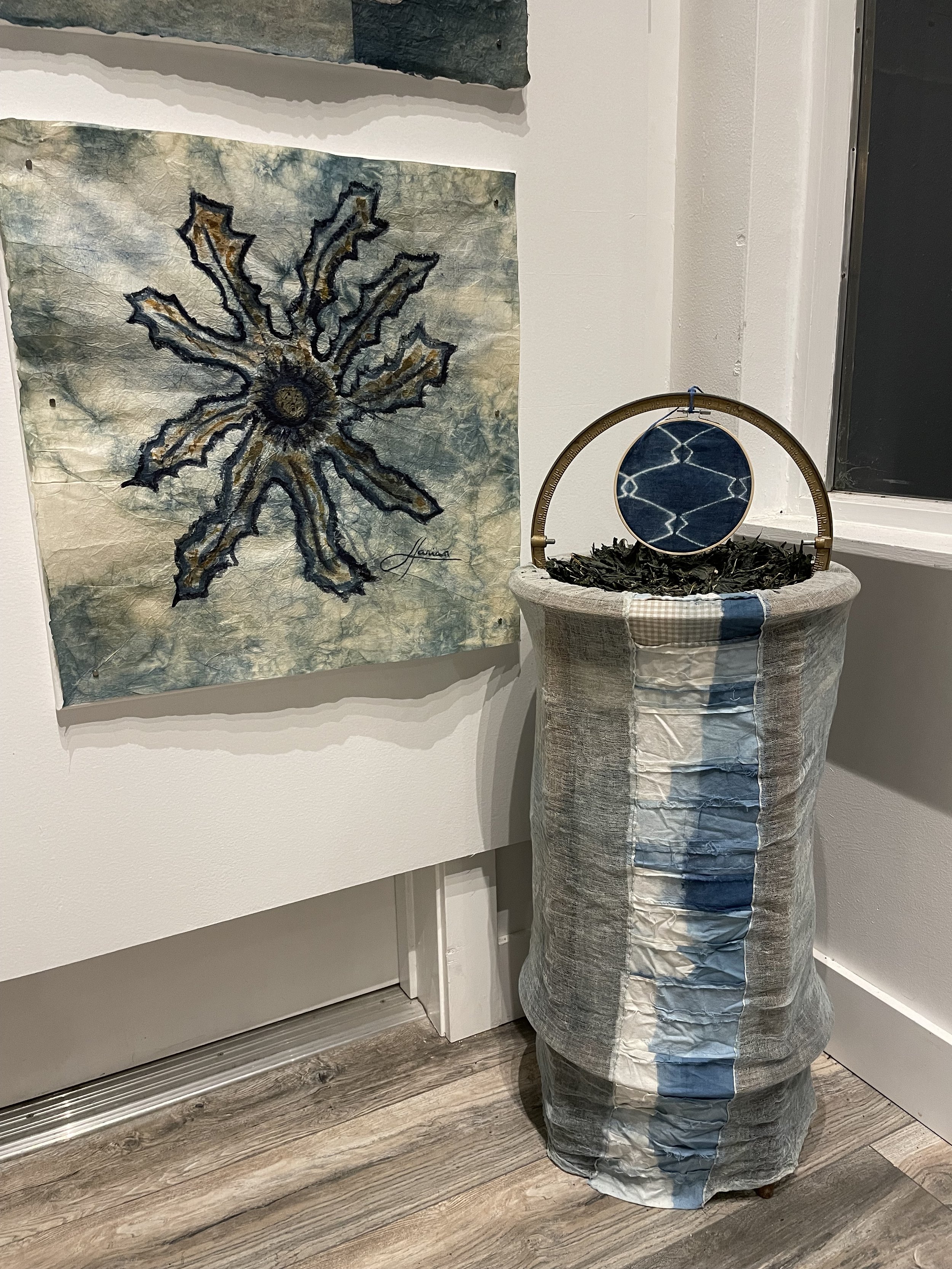Marian Martínez González
Weaving life - Tejiendo la vida?
Eguzkilore - Sun flower
Eguzkilore - Sun flower & stitched shibori circle on the Deeper Well - a collaborative piece with Iris
Marian Martínez González
Studio Location: Barrio La Sota, 39, 2º A 48190 Sopuerta -Bizkaia -Basq Country -Spain
Indigo Species used: Indigofera Tinctoria / Ferrous Vat Recipe
Source of Indigo: Persicaria tinctoria: pigment extracted from my garden.
Indigosfera tinctoria: bought in India
Persicaria tinctoria: pigmento extraido de mi huerto.
Indigosfera tinctoria: comprado en India.
Materials used: Kozo paper, konjac root, persicaria tinctoria pigment, indigosfera tinctoria pigment, kakishibu.
Papel Kozo, raíz de konjac, pigmento de persicaria tinctoria, pigmento de indigosfera tinctoria, kakishibu
What is the primary method?The background is dyed in an indigo vat. The picture is painted with indigo pigment mixed with konjac root and kakishibu.
El fondo esta teñido en una tina de índigo. El dibujo esta pintado con pigmento de índigo mezclado con raíz de konjac y kakishibu.
Type of Vat: The indigo vat that I have used is made with my persicaria tinctoria pigment. The indigo vat I have used is an iron indigo vat drawn from a recipe in an 18th century Spanish manuscript.
La tina de índigo que he utilizado esta realizada con pigmento de persicaria. La tina de índigo que he realizado es una tina de índigo de hierro sacada de un manuscrito español del siglo XVIII.
Artist Bio:
I have been researching and practicing natural dyes for over five years until my interest in Asian arts and crafts led me to discover a true love for indigo dyeing and training in fermentation vat making.
I am the creator and founder of the KOKORO Indigo Culture brand, a textile studio specialized in dyeing with indigo (aizome) extracted from the Japanese indigo (ai) plant called Persicaria tinctoria.
My vision is to preserve the tradition of Japanese indigo and bring a new vitality to the so-called "Japan Blue" through artistic and functional creations, therefore, I am committed to an ecologically based philosophy of shortening the distance with my production to work on a larger scale. more human.
Llevo más de cinco años investigando y practicando tintes naturales hasta que mi interés por las artes y oficios asiáticos me llevo a descubrir un verdadero amor por el teñido índigo y a formarme en la elaboración de tinas de fermentación.
Soy la creadora y fundadora de la marca KOKORO Índigo Culture, un estudio textil especializado en el teñido con índigo (aizome) extraído de la planta japonesa del índigo (ai) denominada persicaria tinctoria.
Mi visión es preservar la tradición del índigo japonés y aportar una nueva vitalidad del llamado “Japan Blue” a través de creaciones artísticas y funcionales, por ello, apuesto por una filosofía con base ecológica de acortar la distancia con mi producción para trabajar a una escala más humana.
Title of Piece 1: Weaving life- Tejiendo la vida
Price: 700 €
Additional notes on method for this Weaving life - Tejiendo la vida?
The tissue papers are painted with indigo pigment mixed with konjac root. The kakishibu is also painted and its color is modified with iron sulfate and sodium bicarbonate.
Los papeles tejidos están pintados con pigmento de índigo mezclados con raíz de konjac. El kakishibu también esta pintado y su color esta modificado con sulfato de hierro y bicarbonato de sodio
Artist Statement about Tejiendo la vida:
Weaving life is a journey of transformation. It is a reflection towards where I want my work to go in order to rebuild everything I have learned and seek new paths.
Working with paper is returning to my inner self, to my dreams of painting and being able to work paper like a fiber is to rediscover my now, my present.
Working with indigo in particular and natural dyes represents a deep connection with the Earth, with my origin and my roots, and when i weaving it reinforces this feeling.
Weaving life es un viaje de transformación. Es una reflexión hacia donde quiero que transcurra mi obra para reconstruir todo lo aprendido y buscar nuevos caminos.
Trabajar con papel es volver a mi yo interior, a mis sueños de pintar y poder trabajar el papel como una tela es redescubrir mi ahora, mi presente.
Trabajar con el índigo particularmente y los tintes naturales representa una conexión profunda con la Tierra, con mi origen y mis raíces y su tejido refuerza este sentimiento.
********
Title of Piece 2: Amalurra - Mother Earth
Price: 650€
Additional notes on method?The woman is painted with indigo pigment mixed with konjac root. The kakishibu is also painted and its color is modified with iron sulfate and sodium bicarbonate. The leaves are from my garden.
La mujer esta pintada con pigmento de índigo mezclados con raíz de konjac. El kakishibu también esta pintado y su color esta modificado con sulfato de hierro y bicarbonato de sodio. Las hojas son de mi huerto.
Artist Statement about Amalur:
This work represents my origin, it represents part of the culture of my land and my work focused on the creation of colors from what Mother Earth gives us.
Amalur is herself the Earth Mother of Basque mythology, and she is the main divinity of the ancient Basque pagan religion.
Everything arises on Earth, and Amalur is the receptacle of everything that exists, of all living beings, and, consequently, the one that enables the existence of the human being itself.
She is the creator of Eguzki (the Sun) and Ilargi (the moon) and at dawn, Amalur gives birth to Eguzki, who crosses the sky during the day to end up returning to Amalur's womb at nightfall. It is then that Mother Earth gives birth to Ilargi, who will travel through the sky during the night hours to return to Amalur's bosom at dawn.
Everything comes from Amalur, the sun, the moon, the winds, the storms... everything emanates from the depths of Mother Earth.
Esta obra representa mi origen, representa parte de la cultura de mi tierra y mi trabajo centrado en la creación de colores a partir de lo que nos da la Madre Tierra.
Amalur es en si misma la Madre Tierra de la mitología vasca, y es la divinidad principal de la antigua religión pagana vasca.
Todo surge en la Tierra, y Amalur es el receptáculo de todo lo que existe, de todos los seres vivos, y, en consecuencia, la que posibilita la existencia del propio ser humano.
Es la creadora de Eguzki (el Sol) e Ilargi (la luna) y al amanecer, Amalur da a luz a Eguzki, que surca el firmamento durante el día para terminar volviendo al útero de Amalur al anochecer. Es entonces cuando la Madre Tierra alumbra a Ilargi, que recorrerá el cielo durante las horas nocturnas para regresar al seno de Amalur al alba.
Todo surge de Amalur, el sol, la luna, los vientos, las tempestades...todo emana de las profundidades de la Madre Tierra.
*****
Title of Piece 3: Eguzkilore - Sun flower
Price: 650€
Additional notes on method used for Eguzkilore - Sun flower:?
The sun flower is painted with indigo pigment mixed with konjac root. The kakishibu is also painted and its color is modified with iron sulfate and sodium bicarbonate.
La flor del sol está pintada con pigmento de índigo mezclados con raíz de konjac. El kakishibu también esta pintado y su color esta modificado con sulfato de hierro y bicarbonato de sodio
Artist Statement about Eguzkilore - Sun flower:
Eguzkilore is the flower of the sun that Amalur gave to human beings to protect them during the night. ·
His cult is very old, as in many prehistoric religions and, therefore, long before the introduction of the sky gods from the Indo-European peoples.
As proof of love for human beings, Amalur created the Eguzkilore, a kind of thistle flower that was once abundant in the Basque mountains and that today is protected.
Eguzkilore means "flower of the sun" in Euskera, the Basque language, and its shape is precisely reminiscent of that of the sun king.
·A Basque legend tells that when human beings began to populate the world neither the sun nor the moon existed.
Frightened by the terrible genies that came out of the bowels of the mountains and chasms, they went to Amalur and begged her to help them.
Amalur created for them Ilargi (the Moon) and later Eguzki (the Sun). In this way they would be protected at night and during the day.
But the evil spirits and the genies, who could not stand the light of the Sun, continued to come out at night, since the light of the Moon did not harm them.
The humans again asked Amalur to help them fight the night genies. Mother Earth gave them one last gift. She created Eguzkilore, a flower with such a shape that when seeing it the beings of the night would believe that it was the Sun and would move away.
Since then, in many Basque homes the flower of the Sun has been placed on the doors of their houses, so that during the night the nocturnal genies do not bother them.
Eguzkilore es la flor del sol que Amalur regalo a los seres humanos para protegerles durante la noche. ·
Su culto es muy antiguo, al igual que en muchas religiones prehistóricas y, por tanto, muy anterior a la introducción de los dioses celestes provenientes de los pueblos indoeuropeos.
Como prueba de amor hacia los seres humanos, Amalur creó a Eguzkilore, una especie de flor de cardo antaño abundante en los montes vascos y que hoy se encuentra protegida. Eguzkilore significa «flor del sol» en euskera, la lengua vasca, y su forma recuerda precisamente a la del astro rey.
Cuenta una leyenda vasca que cuando los seres humanos comenzaron a poblar el mundo no existían ni el sol ni la luna. Asustados por los terribles genios que salían de las entrañas de los montes y simas, acudieron a Amalur y le rogaron que les ayudara. Amalur creó para ellos a Ilargi (la Luna) y más tarde a Eguzki (el Sol).
De este modo estarían protegidos por la noche y por el día.Pero los espíritus malignos y los genios, que no soportaban la luz del Sol, siguieron saliendo por la noche, ya que la luz de la Luna no les dañaba.
Los seres humanos volvieron a pedir a Amalur que les ayudara a combatir a los genios nocturnos. La Madre Tierra les hizo un último regalo. Creó a Eguzkilore, una flor con tal forma que al verla los seres de la noche creerían que era el Sol y se alejarían.
Desde entonces en muchos hogares vascos se coloca la flor del Sol en las puertas de sus casas, para que durante la noche los genios nocturnos no les molesten.
Artists of the Matrix - LInks
Rosa Sung Ji Chang - Baltimore, MD
Catharine Ellis - Waynesville, NC
Debra Ketchum Jircik - Eagle River, WI
Scott C Johnson - Cannon Beach, OR
Marian Martínez González- Basque Country, Spain
Madeline McGarrity - Andover, NJ
Bernadette Puleo - Dix Hills, NY




